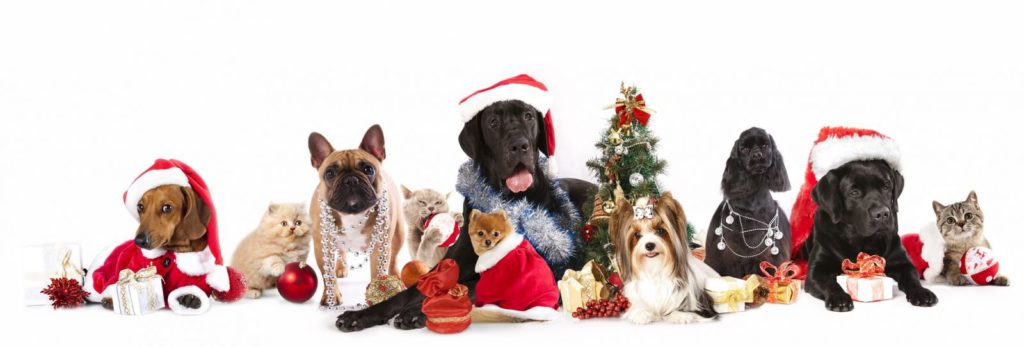
The 2017 holiday season is almost here. I feel that I have a duty as a pet parent to share with other pet lovers the dangers the holidays could bring.
The majority of people know how to keep themselves and their (human) loved ones safe during the holiday season. Most would say that it comes down to common sense. But, how many of us know about safety issues that our pets could face? How many of us know how to handle an emergency dealing with a pet? Did you know that there is a Heimlich maneuver for cats and dogs?
The American Society for the Prevention of Cruelty to Animals (www.ASPCA.org) has plenty of pointers for pet safety during the holidays.
Dogs and cats do not differentiate water bowls – if they are thirsty and they see a vessel with water in it, they’re going to take a swig. In the case of a real Christmas tree, be certain to cover the water. The water may contain fertilizers which can cause nausea in dogs and cats. If the tree water isn’t covered and becomes stagnant, it will be a breeding ground for bacteria which could also make your animal extremely ill. Make sure that your Christmas tree is anchored and secured, so that it doesn’t tip and fall when your cat decides to explore and climb the new really big toy that you’ve bought for them.
Cats, and especially kittens – who are likely experiencing their first holiday season – are drawn to anything sparkling, bathed in colorful Christmas lights. Cats love tinsel. They can easily play with it, batting it around on the tree and carry it around in their mouths. Swallowing tinsel, however, is extremely dangerous to them. It can lead to digestive tract obstruction, severe vomiting, dehydration and could land your kitty on the operating room table.
For both cats and dogs, holly can cause nausea, diarrhea and vomiting. However, mistletoe is an even more dangerous plant. Where for humans, mistletoe means getting a quick kiss, it is perilous for animals. It causes gastrointestinal problems and cardiovascular issues. Symptoms of mistletoe ingestion include abnormal heartrate, hypotension, ataxia, and seizure activity. In extreme cases where a large amount has been eaten, it has led to death. Most varieties of lilies, if ingested, cause kidney failure in cats. If you have pets, artificial plants and flowers are the best option when decorating for the holidays.
Make certain that if you choose to have real-flame candles that your dog or cat are properly trained not to play with them. Be sure to keep a watchful eye on your furry family member when candles are lit. Also, place the candles on a steady surface – one that is not easily jarred or tipped over if an animal happens to jump up on it. The growing popularity of battery-operated candles is making it easier for a pet parent to have the candle-like glow in a room and not have to worry about seeing a tail on fire streaking across the living room.
All wires should be secured so that they cannot be chewed by either cat or dog. A wire can cause a potentially fatal electrical shock to the animal. If you do not have a pre-lit Christmas tree, it is a good idea to make certain that the strands of lights are secured to the limbs of the tree so that they are less tempting for an animal to play with.
Broken glass or plastic ornaments will be very tantalizing to pets. They want to play with and bat around shiny things, especially those that make noise. However, these items are very dangerous for them. Aside from cutting or puncturing your pet, if this stuff is swallowed it can lead to internal damage, possibly even the worst outcome: death.
People and pets love holiday foods and especially sweet foods. Most of us know not to feed our pets chocolate, and anything sweetened with xylitol. Pets become very industrious and crafty when it comes to getting ahold of the foods that are assailing their sense of smell with tantalizing aromas. Keep unattended plates of food up and away from animals, and make sure that lids are securely on trash cans. Turkey (and most other) bones present a choking hazard to both cats and dogs.
T o make sure your pet is not left out of the celebration, looking for toys or treats that cannot be easily destroyed is your best bet.
o make sure your pet is not left out of the celebration, looking for toys or treats that cannot be easily destroyed is your best bet.
For dogs, toys that can be stuffed with treats are highly desirable. Balls that can be chased and fetched are also popular. For cats, who love long and stringy things, yarn- and ribbon-like toys actually pose the most risk. Instead, grab a ball that is too big to swallow, something with catnip or maybe an interactive toy.
In the end, we all need to take the proper precautions to make sure that our pets enjoy the holiday season right alongside us. This article is a small sampling of all the information that is out there to help us keep our pets safe. For more information and ideas please visit www.ASPCA.org, www.petmd.com, and www.bestfriends.org.
About the Author

Becca Hernandez
Student - Fall 2017








